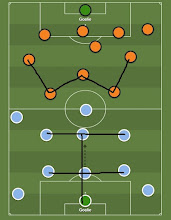A
few underrated Dutch goalkeepers had a chance to play for the big clubs in
Europe and succeeded.
The
Netherlands has been famous for producing modern goalkeepers. They do not only
excel at shot-stopping but are also good with their feet. For years, Dutch
goalkeepers have been considered some of the best in Europe.
The
likes of Jan Jongbloed, Hans Van Breukelen, Ed de Goey, and Edwin Van der Sar
are probably the most famous ones among the fans. Then, there were Stanley Menzo, Marten Stekelenburg, Jasper Cillesen, Tim Krul, and currently Brighton's
Bert Verbruggen, who have had great stints in their clubs and earned
respectable international caps.
However,
there were a few underrated names between the sticks who surprisingly signed
for the big teams and managed to shine during their brief stay there. Here are
those forgotten Dutch goalkeepers who once thrived in the European elites.
Ruud
Hesp (Barcelona)
He
was one of the fairly unknown names in Barcelona’s Louis Van Gaal in his first
spell. Hesp was not exactly Van Gaal’s first choice to sign when he moved to
the Catalan side. He was aiming for his former stars in Ajax, Edwin Van Der Sar
and Ed De Goey. Unfortunately, neither followed him to La Liga. The former
chose to stay put in Amsterdam while the latter opted to join Chelsea instead.
Van Gaal eventually turned to Ruud Hesp, who was already 32 years old at that time.
Hesp
was the key figure in Roda JC’s success in the mid-1990s when they finished
second in Eredivisie in 1995, plus snatching KNVB Cup two years later. Under
Van Gaal, the former Fortuna Sittard shot stopper enjoyed his success as the
first choice ahead of Vitor Baia and won two La Ligas consecutively, plus one
Copa Del Rey in 1998 and UEFA Super Cup in 1997. He even helped Blaugrana to
reach the semifinals in UCL 2000 before their 4-1 humiliation against Valencia
in the last four. His days in Barcelona eventually came to an end following Van
Gaal’s exit. The current Besiktas goalkeeping coach chose to return home in
2000 and retired two years later. Overall, Hesp made 144 appearances and 42
clean sheets for La Liga powerhouse.
Despite
his top form, the Bussum-born goalie was never capped on the international
stage. He did receive a call-up for being part of De Oranje squad in EURO 1996
and the 1998 FIFA World Cup. Van der Sar’s consistent top form for years cost
him his chance to play in the major tournament.
Raimond
Van der Gouw (Manchester United)
He was signed by United as
the experienced understudy in 1996. Van der Gouw was already 33 years old while
moving to Old Trafford. Yet, he slowly gained Sir Alex Ferguson’s trust for the
important matches following his impressive debut against Aston Villa in
September 1996. The former Go Ahead Eagles goalie was picked to replace the
injured Peter Schmeichel in the 1997 Champions League semifinal versus the
eventual champion, Borussia Dortmund, and in the following season when
Manchester United played host to Monaco. Despite failing to win in both games,
Van Der Gouw’s performance earned praise for his numerous crucial saves.
Van Der Gouw made his mark
when he played for Vitesse Arnhem, which he joined in 1988. He already helped
his team get promoted in the first season. The current Shakhtar Donetsk
goalkeeping coach also contributed to Vitesse’s successful campaign in 1989/90
when they finished fourth to make their European debut and reached the KNVB Cup
final. Vitesse also managed to advance to the quarterfinals in the 1991 UEFA
Cup.
The Oldenzaal-born goalie
stayed in Manchester till 2002 and won all major titles with two EPL trophies,
the FA Cup, and the Champions League in 1999. His role in United, in fact, went
further than just playing on the pitch. He was already assigned to be the
goalkeeper coach in 1998/99 for the youth team while serving as the team’s
second fiddle. Overall, he appeared in 60 games and made 27 clean sheets for
United.
Van der Gouw eventually
switched sides to West Ham following the arrival of Roy Carroll. Yet, he did
not make a single appearance for The Hammers. He then moved back to his home
soil after a year in Upton Park and played for RKC Walkwijk and AGOVV,
respectively, till he hung up his gloves in 2007 without getting a single
international call-up.
Sander
Westerveld (Liverpool)
Unlike
the other two, Sander Westerveld was luckier on the international stage. He was
capped six times, including three matches in EURO 2000. He was the key man in
Liverpool’s treble success in 2001, when they clinched FA Cup, Carling Cup, and
UEFA Cup titles. Westerveld also helped them snatch the UEFA Super Cup when
Steven Gerrard and Co. thumped Bayern Munich 3-2.
The
former Twente man who moved to Anfield in 1999 was instrumental in Vitesse’s
impressive campaign in the 1998/99 season. They managed to finish fourth and
qualified for the UEFA Cup. Unfortunately, his stint only lasted till December
2001, or just a few months after winning continental titles with The Reds. The
arrival of Jerzy Dudek, plus his blunder against Bolton in August 2001, pushed him to the exit after making 103 appearances and 42 clean sheets. Westerveld joined
Real Sociedad, where he contributed well to their positive campaign in 2002/03.
In that season, La Real finished second in La Liga behind Real Madrid and
secured one spot in the Champions League.
After
being loaned out to Mallorca in 2004, he returned to England by playing for
Portsmouth and Everton before going back to the Netherlands and playing for
Sparta Rotterdam. Westerveld finally retired in 2013 after his two-year spell
with Ajax Cape Town. His last club in Europe was Monza, which was competing in
the Italian third tier in the 2010s.



Comments
Post a Comment